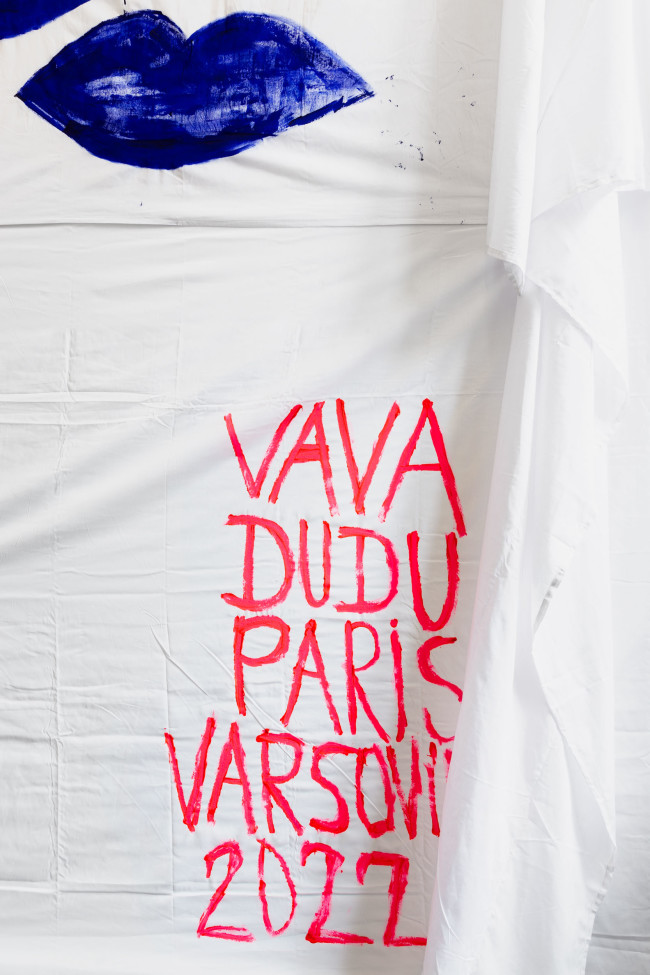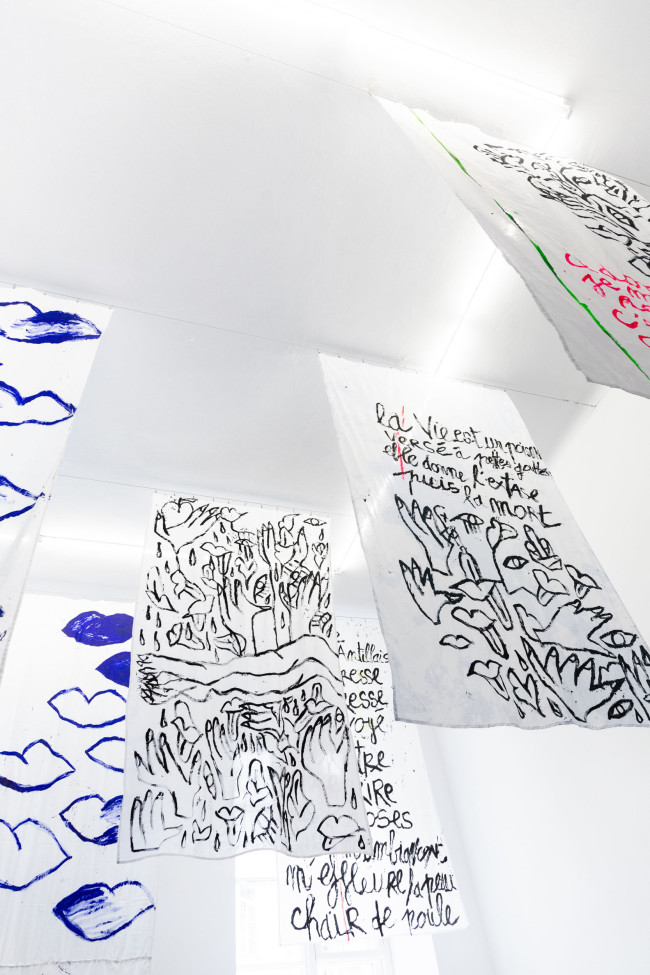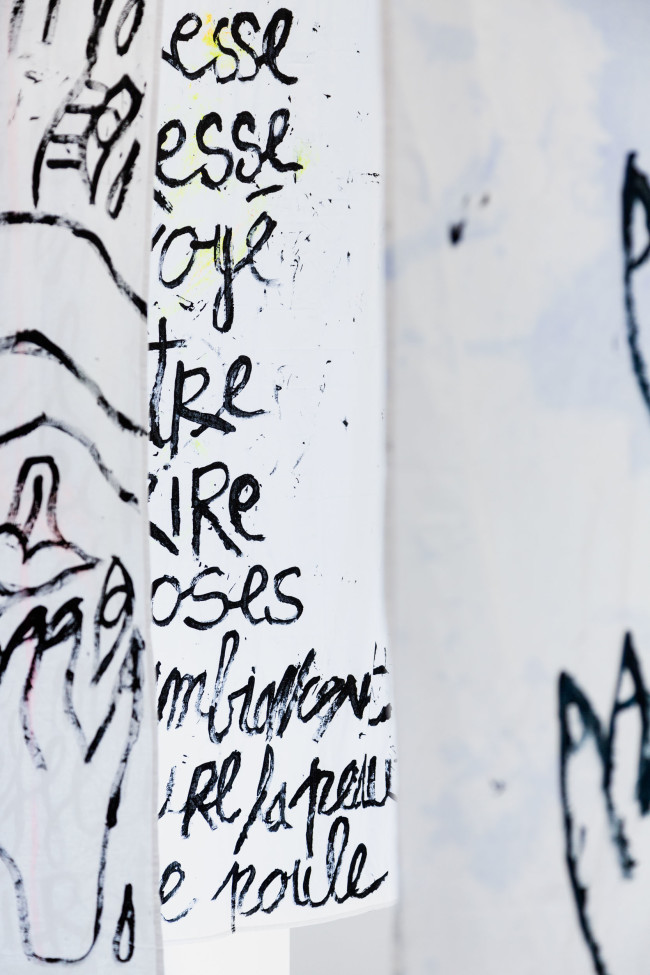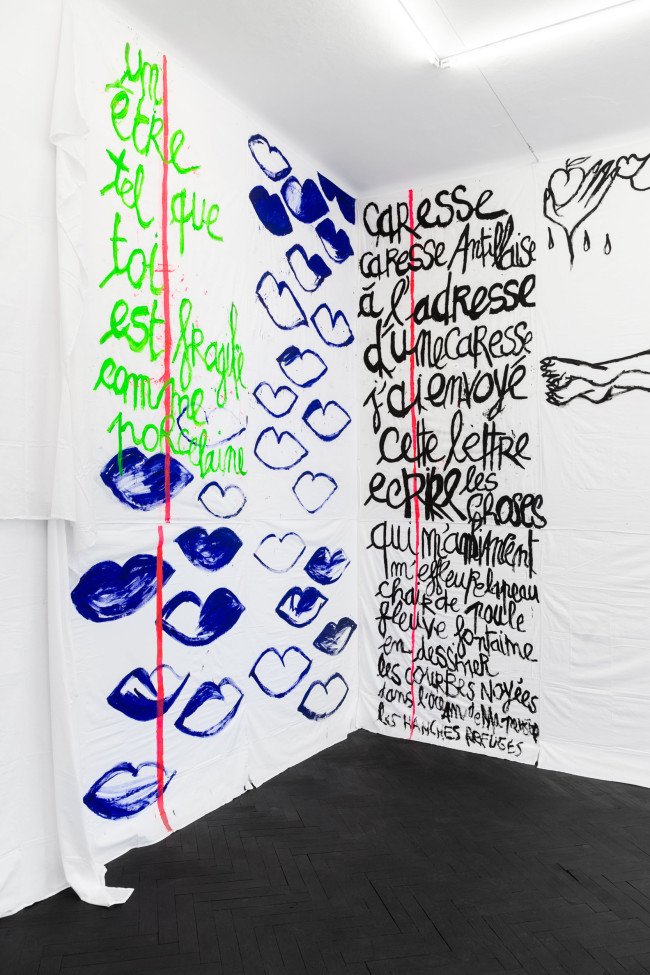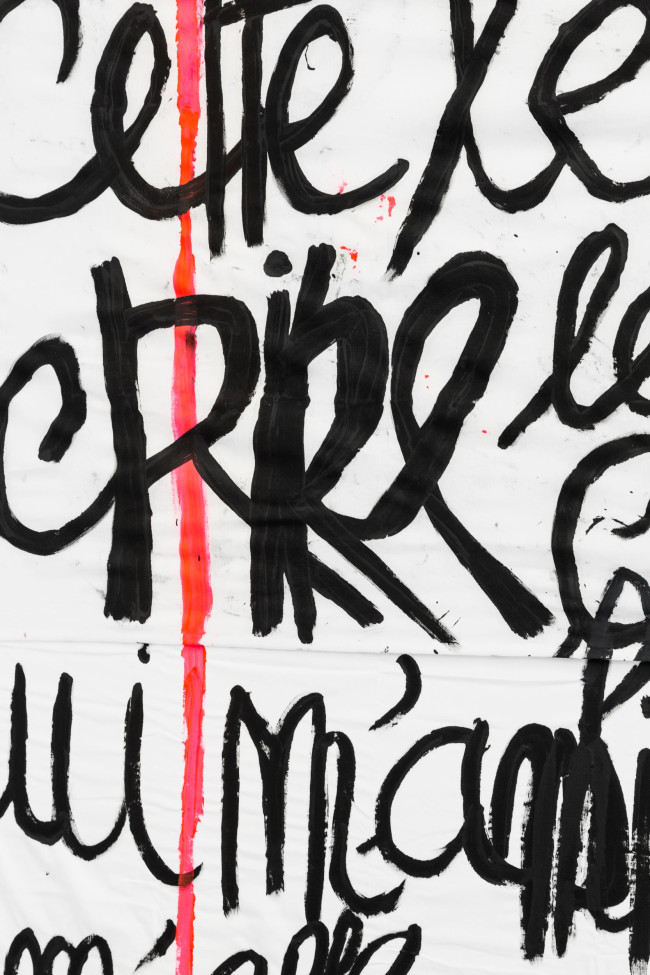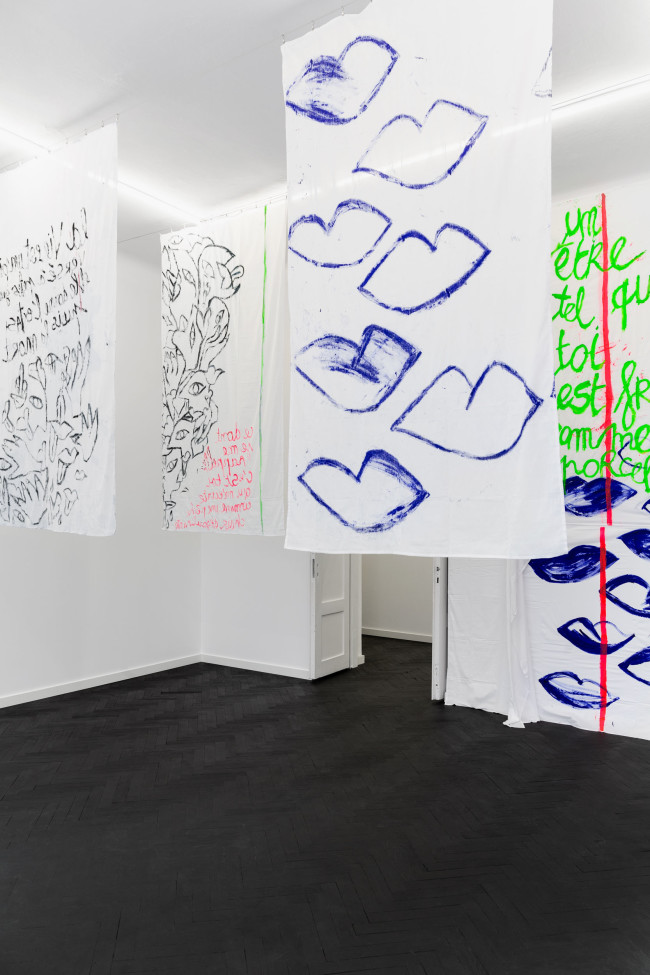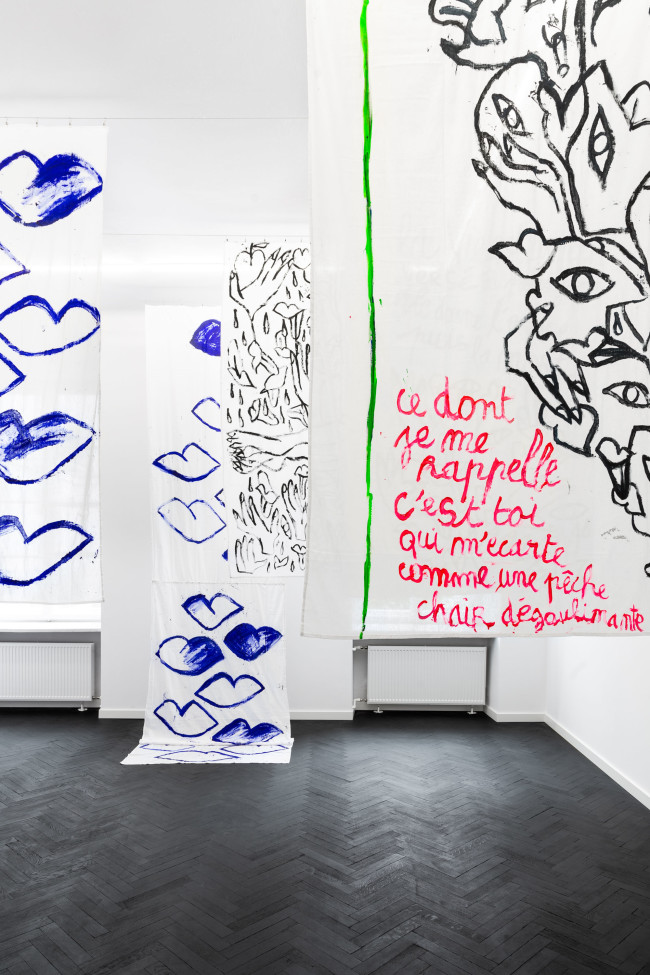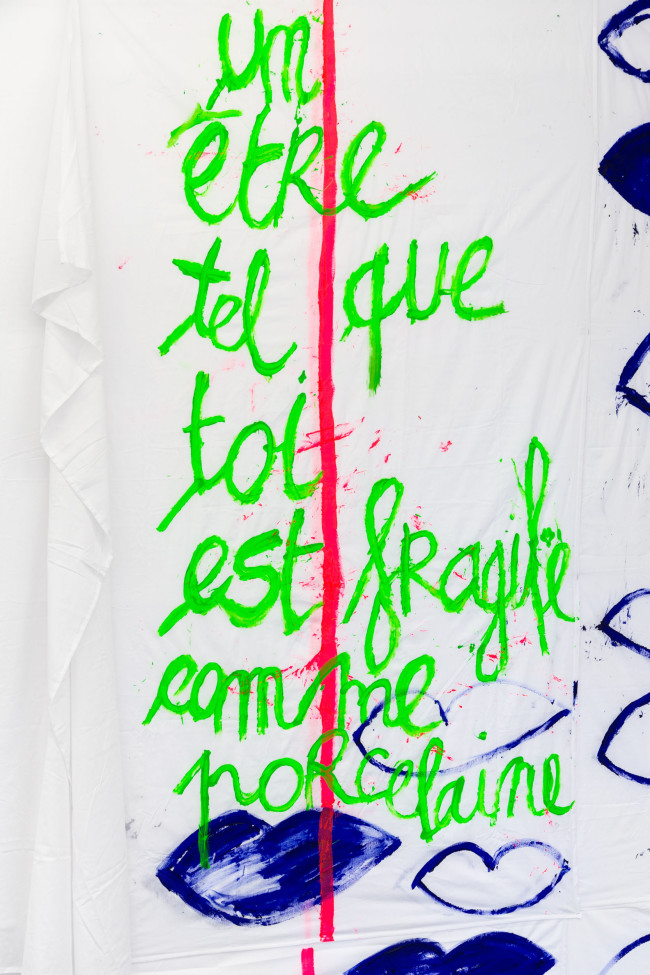Vava Dudu

Text: Maja von Horn
Photography: Gosia Turczyńska
It’s Vava Dudu’s first time in Warsaw. She’s in town for the opening of her exhibition “Caresse”, which is on view at the Gunia Nowik Gallery until September 10. Vava may look rather avant-garde, sporting long neon-pink-and-green braids and a blue heart painted on her forehead, but when she starts laughing, it is the warmest, most contagious laughter I’ve come across in a long while.
Grew up in Paris in the seventies in a Martinican family, and quickly rose to prominence in the fashion world with her upcycled pieces. Working for Jean-Paul Gaultier on his first haute couture collection in 1997 led to her winning the prestigious ANDAM prize for young designers. Not attached to any particular medium, she added music to her portfolio early on as a member of the electro-punk group La Chatte. It is the spirit of poetry above all, though, that, acts as a driving force for her daily art practice, whether she is drawing, painting, or writing.
Throughout the years, Vava Dudu has designed clothes for Björk, Peaches, and Lady Gaga, to name just a few. Her work has appeared in numerous exhibitions, including Palais de Tokyo, Musée d’Art Moderne de Paris, Fondation Galeries Lafayettes in Paris, Komplot in Belgium.
Vava Dudu, Caresse installation at Gunia Nowik Gallery, 2022. Courtesy of the artist and Gunia Nowik Gallery.
Maja von Horn: You called your Warsaw exhibition “Caresse”. Is it a love story?
Vava Dudu: The installation I’m showing in Warsaw resembles my bedroom back home in Paris. I do have a pretty big studio too, but it is in the bedroom where I usually create. The installation is made up of multiple bed sheets attached to the walls of the space, on which I draw, paint, write poems and love letters. It’s called “Caresse” because I write about love – about its sweetness, smoothness, about its caresses. Some of the sheets hang in the middle of the room, in front of open windows, with wind blowing on them like on sails.
M.V.H.: Are these poems and love letters a collection from a number of years, or are they examples of your more recent works?
V.D.: I have been writing lyrics for my band La Chatte since the early 90s, and a lot of the poems I use are my song lyrics. But I also wrote new stuff. When I make clothes, I usually use vintage dresses and shirts and write my lyrics on them. Then I add drawings – bodies making out and other illustrations of love.
M.V.H.: Have you ever thought about having your poetry on paper instead of clothes, about publishing it?
V.D.: I’m actually thinking of putting together a book. Writing on paper is very different from writing on textiles though. I think that clothes can convey more meaning. I like the idea of a simple vintage dress with words written across it, which reflect your mood, your thoughts, or just whatever you had on your mind. I love the idea of wearable poetry.
M.V.H.: So each dress is one of a kind?
V.D.: Yes, I travel a lot and bring home vintage dresses from around the world that I later paint and write on. I’m planning to do that in Warsaw as well – check out local second-hand stores and hopefully find something nice. I’m a collector, I bring home items from different places and upcycle them. That’s where fashion meets art – although maybe there’s more art than fashion in it.
M.V.H.: Being a multidisciplinary artist, you express yourself through many different media. Which one is the closest to you – is it writing, painting, music or fashion?
V.D.: They’re equally important to me, although very different. When I write or make clothes, I usually work from the round bed in my bedroom. I quite rarely use my studio. Creating things in your bed is a very intimate situation, I like to be alone there, I need this intimacy in order to be able to write. I write only in French, and play a lot with words and their meanings. But when I perform with my band, when we play during festivals, or we just do a show, I give a piece of myself to the audience and receive their energy in return. I love that exchange. We’ve just played at a festival last week, and I met a guy who had all the lyrics from one of the songs I wrote for La Chatte tattooed on the side of his body! It’s a fantastic feeling, when you see that you have touched someone with your words. It’s two opposite energies – there’s being alone and writing lyrics in your bed, and then there’s singing them out to the crowd, from the stage. But in both cases I’m seeking dialogue with other people. I do that with my drawings, too. Drawing is the best way to say what I want to say without all the “blah blah blah.”
M.V.H.: As the queen of the Parisian underground scene, have you ever wanted to live in a different place?
V.D.: I was born and raised in Paris, in the northern part of the city, Barbès. My parents came to France from Martinique when they were twenty years old. I’ve always felt more Parisian than French, never lived anywhere else until just a few years ago, when I decided to move to Berlin. I stayed there for almost six years. Apart from Paris and Berlin, I like Japan a lot. That’s where I got the first opportunity of my career, about thirty years ago. My first agent was from Japan, the first gallery that signed me was there as well. I have a lot of love for that country and I go there quite often.

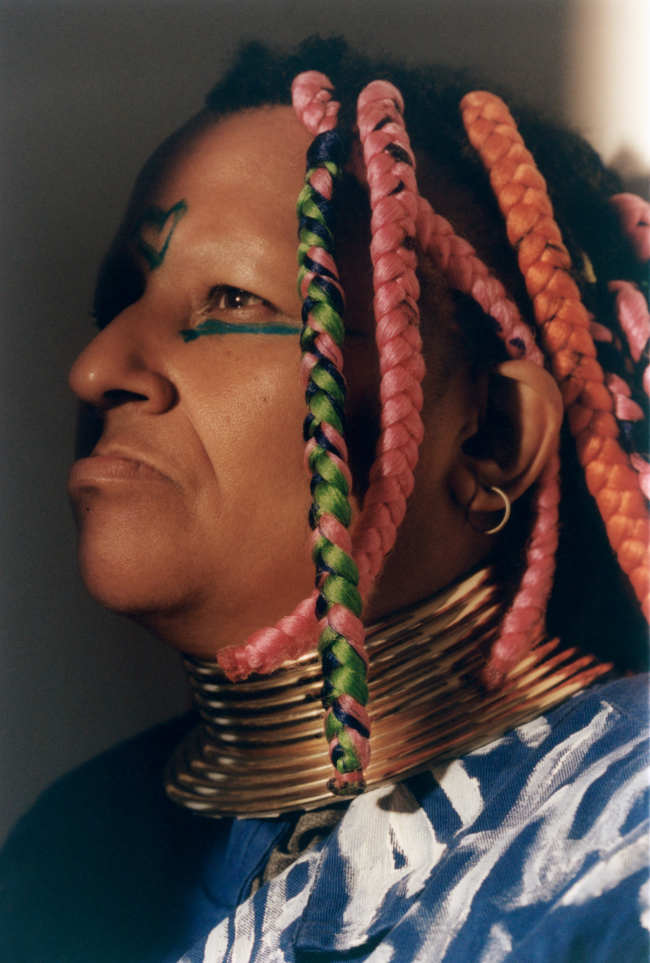
M.V.H.: Your teenage idol was Jean Paul Gaultier. Then, in 1997 you got to work with him on his first haute couture collection. What was so appealing about him?
V.D.: Working with him was my biggest dream as a teenager. Back then, it was Jean Paul Gaultier, Rei Kawakubo, and Yoshi Yamamoto who had the biggest impact on me. Gaultier had a very democratic approach to fashion. He cast all types of girls in his shows – Black, Arab, short, tall, fat and skinny, not only from modeling agencies, but recruited straight from the street as well. It reflected our society, it was a modern approach. Unlike many designers back then, he wasn’t elitist, he didn’t care about the elite. He was always interested in all types of people.
M.V.H.: Later you went on to create a fashion duo with Fabrice Lorrain.
V.D.: Yes, together we designed collections of unique pieces for several years. In 2001 we received the ANDAM award, which is a prestigious prize for young, upcoming designers in Paris.
M.V.H.: But even then you did not decide to start your own label, to start producing and selling more pieces?
V.D.: No, we were doing everything ourselves, with our own hands, so of course after a few years there was a moment when we couldn’t keep up with the demand. If you look at some really successful duos, like Yves Saint Laurent and Pierre Bergé, one person is the creative, and the other one is responsible for business. Fabrice and I are both creatives, and that never works in the long run.
M.V.H.: You’re famously a nonconformist. I heard that you refused to make a dress for Céline Dion, because you didn’t like her music.
V.D.: I was very young back then. It was the early 90s, I did a lot of beading on dresses at that time. I knew a girl in Paris who started working as a stylist for Céline Dion. She went to Quebec and gave me a call asking if I could do a beaded dress for her. It would take a month for me to make, plus I wasn’t a fan, so I refused. I remember I told her that if it was Courtney Love, I’d do it.
M.V.H.: Have you ever compromised on anything?
V.D.: Not really. I cherish my freedom more than anything else. That’s why I do many things – I make music, I paint, I make clothes. If I did only one of those things, I’d definitely have to compromise to be able to make a living. You can’t live off of ten unique dresses. I don’t want to compromise, I prefer to do more things, but my way. I like to travel, I like meeting new people. I could never work as a designer for one brand, sitting in the same office, with the same people every day. It’s not possible for me.
M.V.H.: Later on, there were many famous singers who wore your clothes – Björk, Peaches, and Lady Gaga, to name just a few.
V.D.: I met Nicola Formichetti in London when he was 20 years old. Soon after that, he started working as Lady Gaga’s stylist and asked me to send him some of my designs. I remember it was the beginning of Facebook, he was probably the first person I wrote to on that platform. So I packed the clothes in a box and sent them to the US. Gaga chose a coat I made for her music video “Bad Romance” and boom – it’s there forever, she really made it immortal.
M.V.H.: As of right now, the video has 1.5 billion (!) views on Youtube.
V.D.: I know, it’s crazy. Since this video came out, I was asked to do all sorts of things, including fashion workshops for kids, especially those with some issues or special needs, which I still do, and I love it.
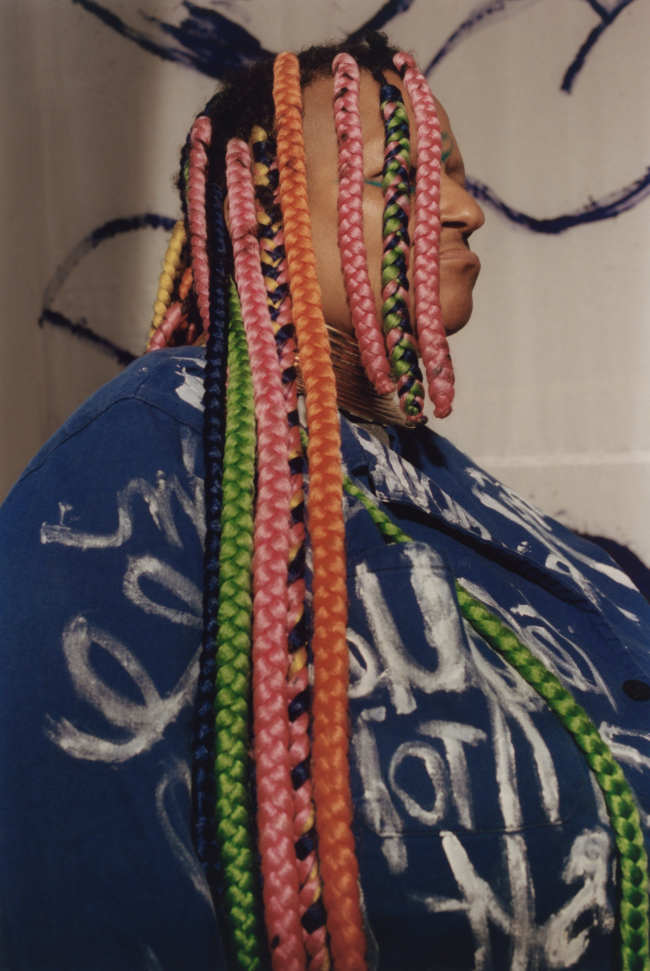
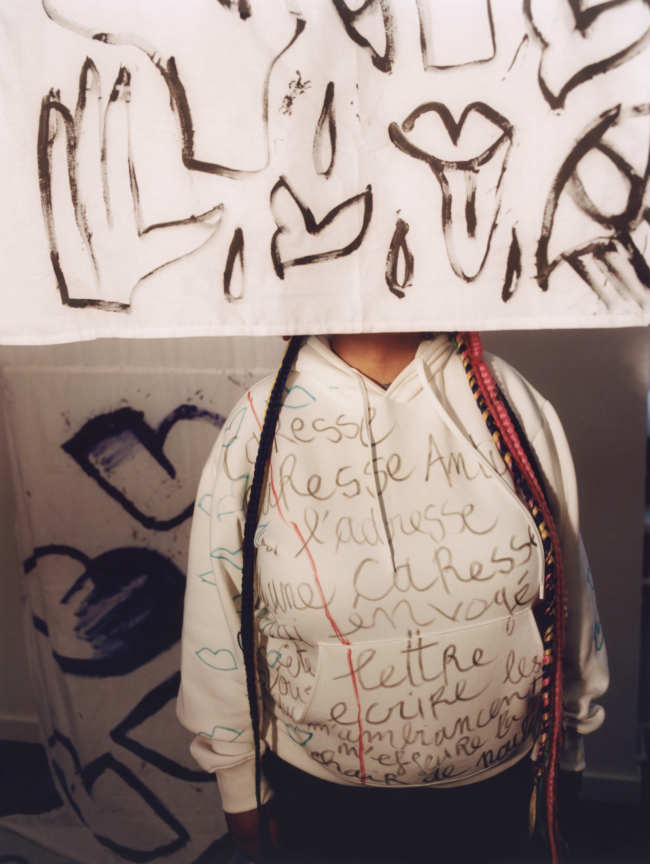
M.V.H.: You’re having one of those workshops at The Museum of Warsaw.
V.D.: Yes, I’m really happy about it. During these workshops, we customise silk scarfs and T-shirts by painting and drawing on them. We spend all day together upcycling fashion.
M.V.H.: In the face of the environmental crisis, it’s probably more important than ever to teach kids alternative, sustainable ways for great, individual style.
V.D.: When I started in fashion 30 years ago, I didn’t have money, so I would always go to vintage stores for clothes, but it wasn’t as popular as it is now. Now everyone has to care about the environment, whether they have money or not. You can’t buy stupid clothes anymore, just because you like them. They should be of a certain quality, something that you could later pass on to your kid or a friend. I want to teach the kids in my workshops that it’s cool to take care of your clothes, that it’s cool to paint on your T-shirt, instead of buying an expensive one. I’d like to do more and more of these workshops in the future.
M.V.H.: You have a very avant-garde image, far from a typical Parisian girl. I love the bright blue lines under your eyes, there’s a blue heart painted on your forehead. Where does that come from?
V.D.: When I was a teenager I spent a lot of time in museums and galleries, especially in the Louvre. I loved the Egyptian antiquities collection, and I think all of that is coming back to me now. That’s the best thing about growing up in Paris; that’s how I discovered art. I realised you can make something beautiful yourself. It was never about money for me. The process of creation is what I got fascinated with.
M.V.H.: Was it your parents who took you to the museums?
V.D.: No, I did that on my own. Sometimes things are not okay at home, with your parents. I just wanted to be myself, to do my own thing.
M.V.H.: How has Paris changed in recent years?
V.D.: About a decade ago I moved to Berlin, because Paris felt too conservative for me, too boring. But in the last couple of years it changed a lot – maybe it’s the new generation that gives it a fresh, colourful vibe. There’s more diversity in the fashion industry as well, it looks more like Jean Paul Gaultier’s shows back in the day – different skin colours, body types, faces. All kinds of beauty, finally.
M.V.H.: Do you think it’s easier or more difficult to be a young designer now than when you were starting?
V.D.: It’s definitely easier to get noticed, thanks to social media.
M.V.H.: But there’s so much fashion on Instagram, the competition is really intense.
V.D.: If you do something different than others, you’ll get noticed. If you have a strong message, you’ll reach people much faster than before. I had to go to the post office and send invitations to my shows by mail. Now everything is so easy.
Vava’s Favorite Places in Paris
- Bistro: Chez Jeannette
- Restaurant: La Chope Des Artistes
- Flea markets: Porte de Clignancourt & Porte de Montreuil
- Vintage shop: Boutique Noir Kennedy
- Art center: Le confort moderne in Poitiers
- Museum: Palais de Tokyo
- Emmaus charity shops in France

